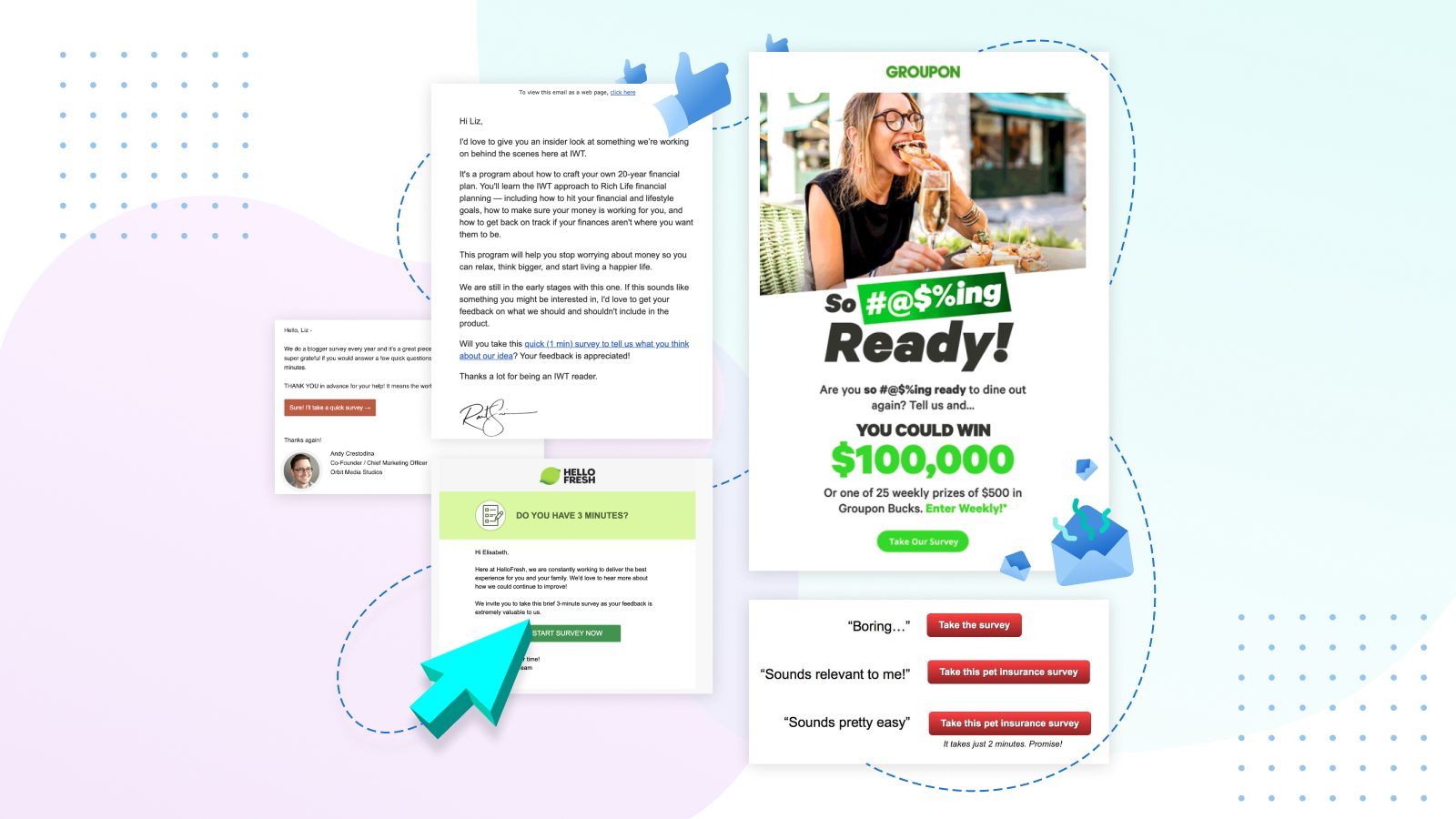It’s all too common for marketers and businesses to rely on intuition, assumptions, or guesses.
Surveys remove this guesswork. They allow you to get real-life feedback from customers, as well as your target audience.
With this feedback, you can:
- Iterate your products and services to meet your market’s needs;
- Create marketing campaigns that resonate with your audience;
- Better serve your customers;
- Increase customer retention and loyalty;
- And ultimately, increase your sales and profitability.
However, while many companies know they should run surveys more regularly, they face a common struggle — it can be difficult to get survey participants.
That’s where email marketing comes in. The average email marketing click-through rate is a whopping 2.5%. Meanwhile, the click-through rate on Facebook feed ads is 1.11%, according to Smart Insights.
Email marketing’s high click-through rate and affordability make it a great channel for promoting and getting responses to your next survey.
In this post, we’ll show you 9 ways to send strategic, smart survey emails, so you can gather critical business data and marketing insights.
1. Embed an interactive survey with AMP for Email
AMP for Email is a technology that allows marketers to easily add interactive and dynamic elements to their emails — like polls and surveys — that subscribers can complete without ever leaving their inbox.
Related: How to build AMP forms in email and 5X your responses
By reducing the steps subscribers need to take, interactive AMP email surveys can increase survey completion rates.
Pro tip: Dyspatch allows you to easily embed interactive AMP surveys within your email — no coding required.
 Chad S. White, Head of Research at Oracle Marketing Consulting and author of Email Marketing Rules
Chad S. White, Head of Research at Oracle Marketing Consulting and author of Email Marketing Rules
“AMP for Email and CSS-based interactivity make surveys easier for subscribers to complete. That’s because subscribers can immediately see the survey without clicking through to the web and make their selections and input their answers inside the email itself. All of that saves them time and clicks, which increases survey completions significantly.
We’ve been using interactive email polls with some of our clients for years to great effect. We’ve found that they’re even better when you also use live content to show a real-time tally of results in the email.”
2. Incentivize subscribers
Often, a simple freebie or gift can encourage subscribers to take your survey. Here are a few freebie ideas you could try in your next survey email:
- Offer all survey respondents a $5 Amazon gift card.
- Give four randomly-selected survey respondents a $50 gift card.
- Share an exclusive digital guide or video with survey respondents that educates subscribers on a topic they want to learn about.
- Donate a certain amount to charity for every survey response you receive.
If you have the budget for it, you could also offer larger gifts, like a free vacation or a new iPhone.
Groupon incentivizes their subscribers to complete a survey by offering a $100,000 grand prize, as well as 25 weekly prizes of $500 in Groupon Bucks.
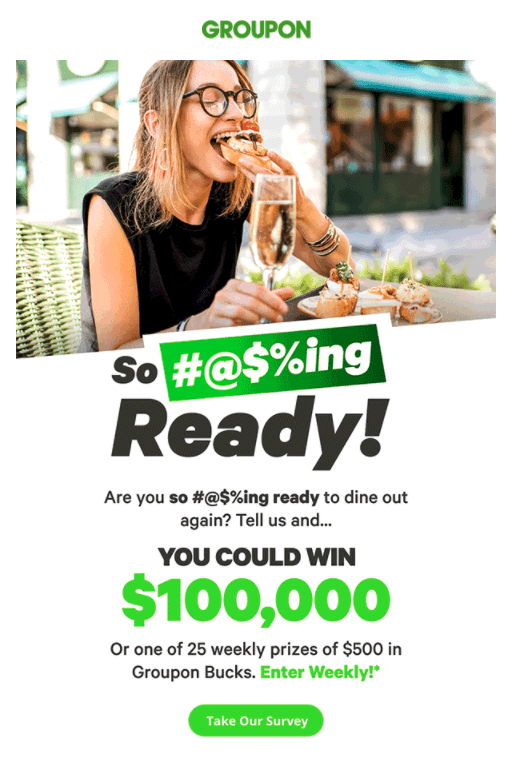
 Julia McCoy, Founder of Express Writers
Julia McCoy, Founder of Express Writers
“Surveys are a GREAT way to get to know your audience even better, but to get a great response from a survey to begin with, it’s important to cater the message around subscribers’ interests. Don’t just formulate it around your question. Offer them something of value.
For example, every time I ask my audience to fill out a survey, I give them 2021 statistics hot off the press that affect how they work as creators, and/or a tip about writing/creating that will help their work output or improve their mindset.
This results in more engagement with the survey and appreciation of the email, because I gave them something of value — I didn’t just ask for something.”
3. Create a short, simple survey
Subscribers are more likely to finish easy surveys that don’t consume 30 minutes of their day!
You can make your surveys simpler by:
- Using straight-forward, multiple-choice questions. Research by SurveyMonkey showed surveys beginning with a multiple-choice question had an 89% completion rate, while surveys that started with an open-ended question only had an 83% completion rate.
- Keeping your survey short. As survey questions increase, completion rates decrease. On average, 10-question surveys have an 89% completion rate, while 30-question surveys have an 85% completion rate, according to SurveyMonkey.
This Net Promoter Score (NPS) survey email from DigitalMarketer is a good example: it’s short and includes just one simple question.
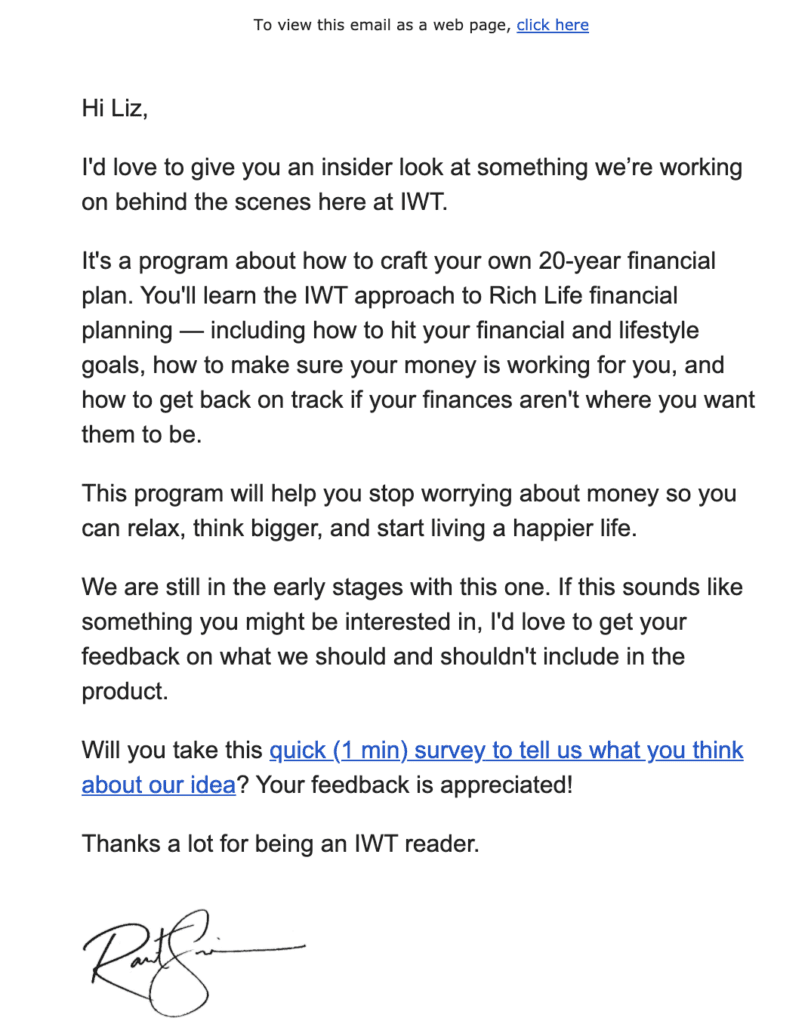
4. Give subscribers a clear call to action (CTA)
A call to action (or CTA) is a request to complete a specific step or action. To increase your click-through rates and survey completions, you should make it very clear what you want subscribers to do when they read your emails.
Andy Crestodina, Co-Founder and Chief Marketing Officer at Orbit Media, runs an annual research survey. Email marketing is one of the primary ways he promotes this survey, and in his survey emails, he focuses subscribers on one call to action — taking the survey. It doesn’t get much clearer than that!
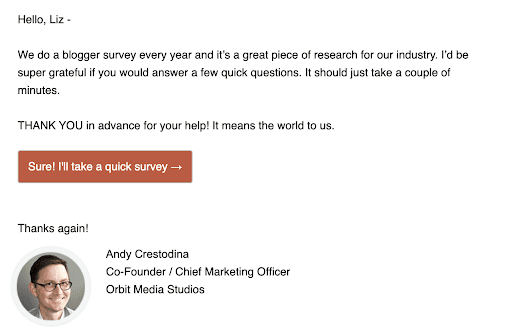
Notice how Crestodina uses a call-to-action button color that stands out on the white background. A contrasting, eye-catching call-to-action button can increase your email click-through rates.
In fact, one study shows using a call-to-action button, instead of hyperlinked text, can increase click-throughs by 127%.
 Andy Crestodina, Co-Founder and Chief Marketing Officer at Orbit Media
Andy Crestodina, Co-Founder and Chief Marketing Officer at Orbit Media
“No one clicks or taps anything until they’ve done a split second cost/benefit calculation. If the perceived cost exceeds the perceived benefits, no click! And no new survey response.
So to increase the performance of a call to action (better CTR for your CTA) try to make the cost smaller or the benefit bigger.
- Make the CTA sound specific and relevant.
- Make the CTA sound quick and easy.”
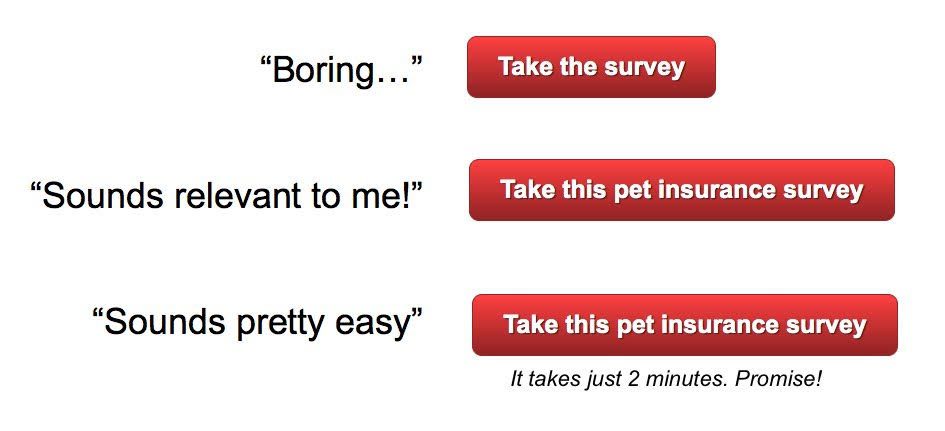
Related: How to Write Great Headlines and CTAs: 21 Creative Examples
5. Write readable surveys and emails
Throw away your high school writing rules. To increase survey completion rates, your goal isn’t to sound like Shakespeare or Charles Dickens. Instead, make it ridiculously easy for people to quickly read your emails. You can increase email readability by:
- Writing short, simple sentences, words, and paragraphs.
- Using tools like the Hemingway Editor to measure your copy’s readability and get advice on improving clarity. Shoot for a 7th grade reading level or below to make it easier for subscribers to read your emails.
- Writing sentences in active voice, instead of passive voice. (For example, “The dog caught the ball” is active voice while, “The ball was caught by the dog” is passive voice.)
 Rachael Pilcher, Founder of Mighty Fine Copy
Rachael Pilcher, Founder of Mighty Fine Copy
“The key to any successful copy is to write with your one ideal reader in mind. Who are they? Why did they sign up to your list? What are they hoping to learn from you? Will they find this email interesting?
Once you’ve finished drafting your email, read it out loud. This is a great way to weed out any words and sentences that sound stiff, weird, or out of character for your brand. What we write is often very different from how we speak — so this simple exercise can quickly take your emails from *yawn* to engaging.”
6. Tell subscribers why you’re surveying them
Does your survey have a greater purpose or mission? Will the survey results impact your subscribers and if so, how?
Let your subscribers know why you’re surveying them and why it matters to them specifically. This can make them feel like they’re a part of your mission — and also show how the survey results may benefit or impact them.
For instance, Ramit Sethi, Founder of I Will Teach You to Be Rich, explains he’s launching a new course on financial planning and surveying subscribers to find out what he should include in the course.
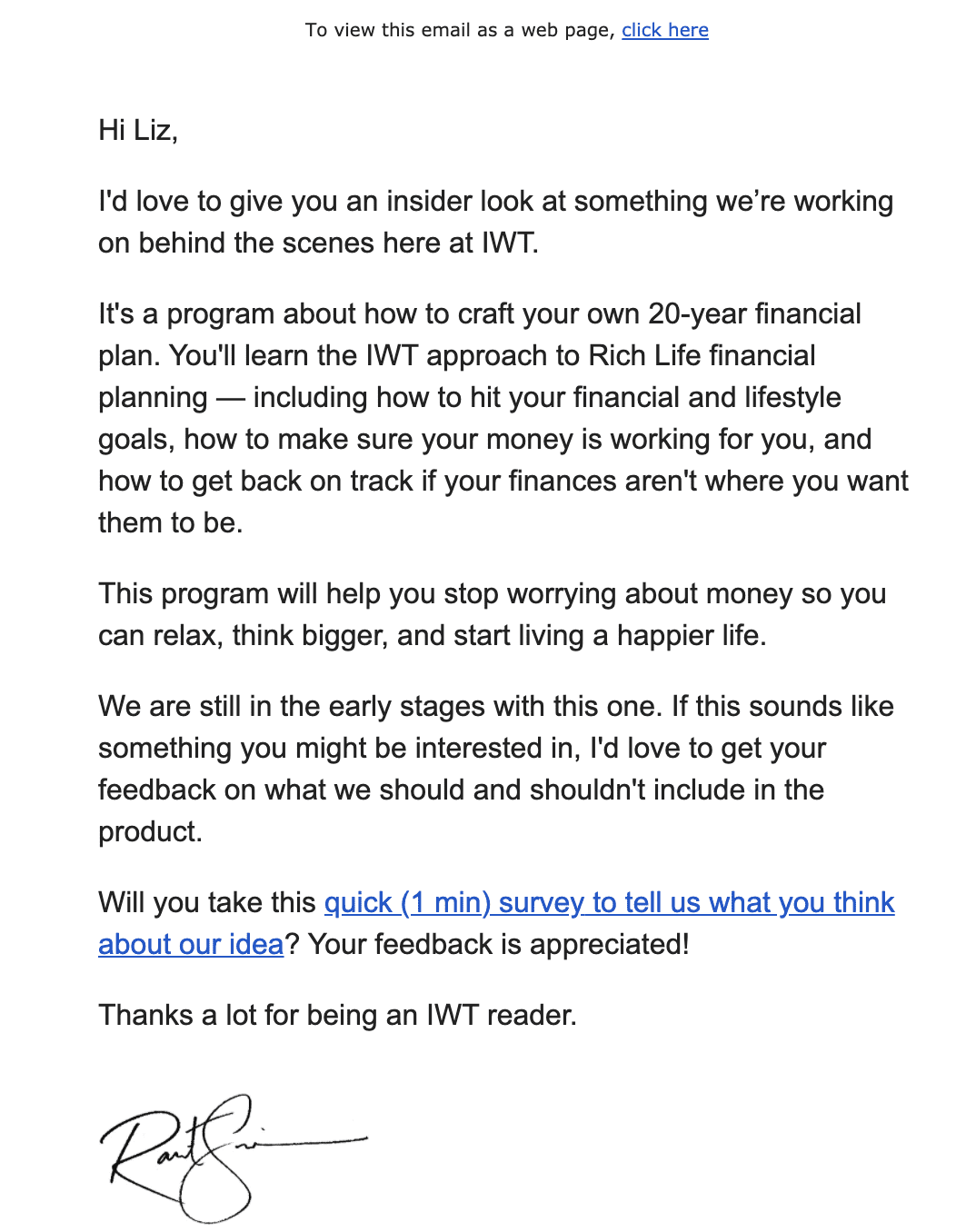
 Matthew Smith, Co-Founder of Really Good Emails
Matthew Smith, Co-Founder of Really Good Emails
“Let your user know why their input is essential. They don’t want to just be a number. No one does. Show them that they have something you think will be valuable. And also let them know what you plan on doing with the survey results that will benefit them.”
7. Be up front about survey length
Whether your survey will take one or 10 minutes to complete, you should inform subscribers of this length right inside your email copy. That way, they know what they’re committing to and can set aside the right amount of time to complete your survey.
You can even include a progress bar in your survey. Progress bars let people know what percentage of the survey they’ve completed, which can prevent drop-off and increase survey completion rates.
HelloFresh makes sure to inform subscribers it’s a “brief 3-minute survey” inside their survey email below.
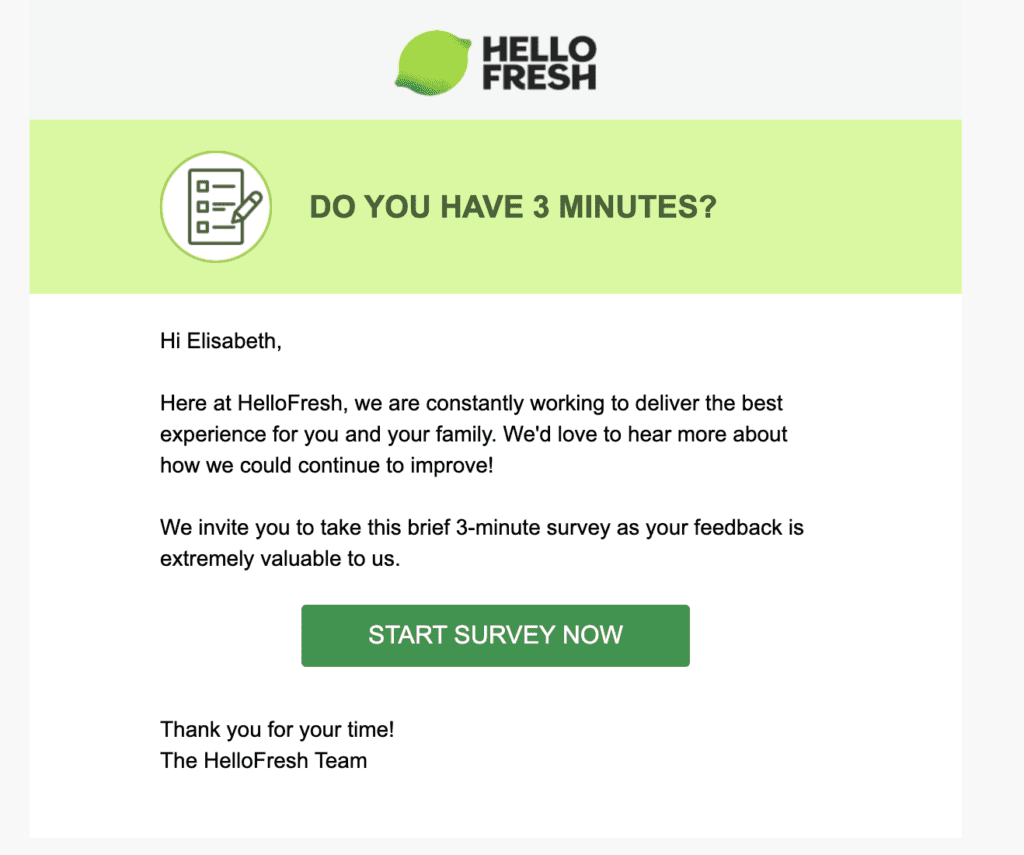
8. Optimize your email subject lines
A great email subject line will increase your open rates, click-through rates, and survey completions. Here are two different approaches you could take in your survey email subject line:
- Promote your survey. If you take this approach, try including the time it takes to complete your survey as well. For example, your subject line could be: “2021 Email Marketing Survey (takes 2 minutes!)”.
- Highlight your prize or freebie. Another approach is to highlight your incentive in your subject line. This lets readers know what’s in it for them right away.
 Ann Handley, creator of TotalAnnarchy and CCO of MarketingProfs
Ann Handley, creator of TotalAnnarchy and CCO of MarketingProfs
“1. Use YOU + YOUR like you just picked up a year’s supply at a BOGO sale. Right in the subject line; directly in the copy. “You” signals intimacy, belonging, relevance.
You will connect with your reader better. And you want to connect with one other person — not an “audience.” Not a “segment.” Not a “list.” One reader. At one time. In one inbox.
2. Add an element of the aspirational. What does your reader want the most? How can you craft that world for them — make them feel a little closer to their dream, a little closer to success? How can you lift people up? Approach everything you write from that point of view.
For example, a subject line might evolve from “10 Tips for Better Emails” to “10 Ways to Make Every Email You Send Impressively Successful.”
Because it’s not about writing / sending / producing great emails… it’s about getting the results you need, deserve, expect.”
9. Remind subscribers with a follow-up email
If subscribers don’t complete your survey after receiving the first email, send them a follow-up a few days later to remind them.
To ensure you don’t send a follow-up to subscribers who already completed your survey, you can build a segment of people who didn’t click on the survey link CTA in your first email. Then, you can send your second reminder email to that segment only.
Boost Your Survey Response Rates (and Business Results)
If you want to understand your subscribers and customers, email surveys are a must. They give you direct, insightful feedback to make your entire marketing strategy — and even your business strategy — better.
With these nine tips, you can send surveys email subscribers want to fill out, increase your completion rates, and gather more feedback than ever before.
To really wow subscribers and create a friction-free experience, use interactive AMP for Email surveys. With Dyspatch, you don’t even need to code your AMP Emails. You can use pre-built email template blocks to create your interactive AMP survey in just a few minutes.
Learn more in Dyspatch’s guide: Everything You Need to Know About AMP For Email.
